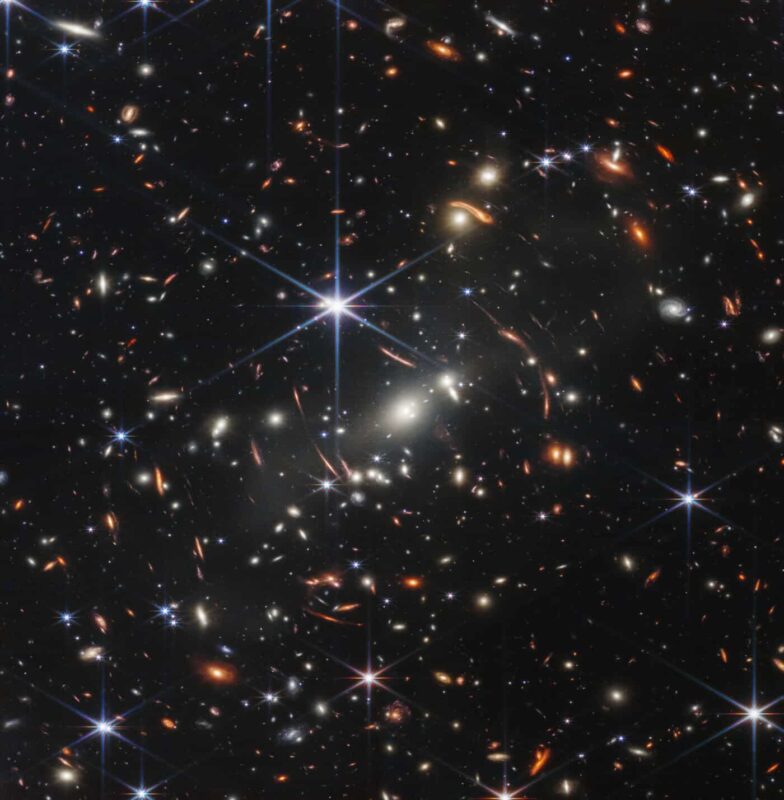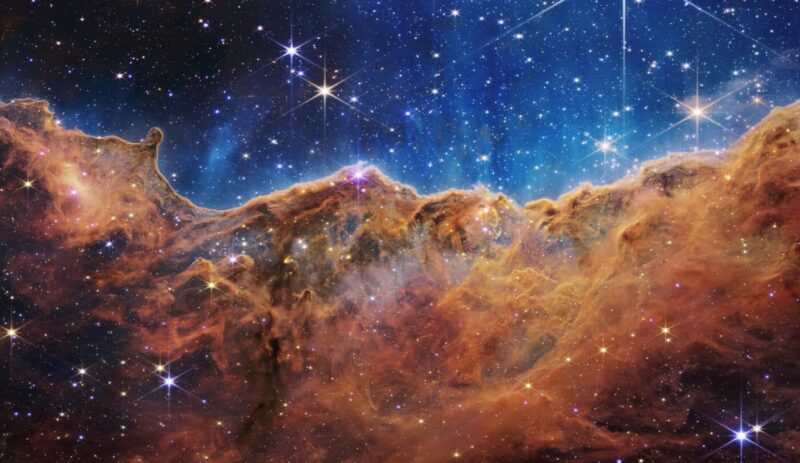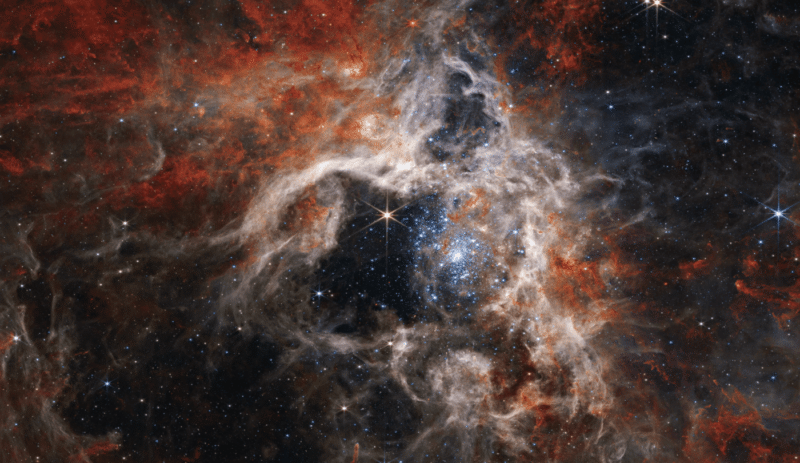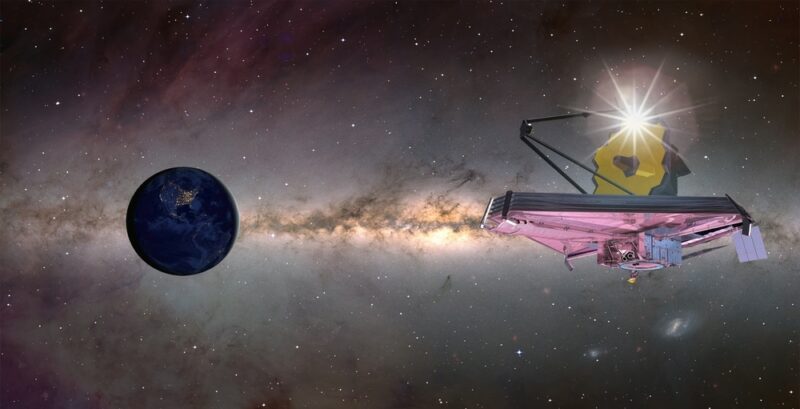God and the Big Bang
Have you looked up at the sky on a dark and clear night?
Few of us can fail to be struck by the glittering beauty of the night sky. Simple yet splendid, it is an experience that can startle us if we choose to glance up. We have the sense that we can reach out and touch infinity. We feel really small … yet we feel close to something that is really big.
In the past few weeks, a new telescope operating a million miles from Earth (four times further than the Moon) has begun to send back astonishing photographs. These are the most distant objects in space ever seen. They are majestic and stunningly beautiful, they made headlines around the world, and there will be more headlines in the months to come. But these photographs also bring us face to face with profound questions:
What is our place in this cosmos? What if we are not alone? And, could scientists discover how our universe began?
It’s called the James Webb Space Telescope.
Breathtaking Photographs
It’s not often that the President of the US makes a public statement on a science project, but it happened in July. Joe Biden himself, unveiling the first photograph from James-Webb, commented that we now have “a new window into the history of our universe”.
That first photograph, “Deep Field” depicts thousands upon thousands of galaxies, each containing billions of stars, and an incalculable number of planets. As Biden said, the numbers are “mind-blowing”. But to really grasp the immensity of this image, think about this: if you take a single grain of sand and hold it out at arm’s length, that’s the area of sky covered by this photograph. The fact that a mere pinprick in the night sky could reveal such a dazzling array of stars is almost beyond comprehension. What new worlds could lie within these galaxies? What strange civilisations could they harbour?
Deep Field – thousands of galaxies, billions of light years away — each one containing hundreds of billions of stars
Deb Haarsma is President of Biologos, which seeks to bring together Christ-centred faith with rigorous science. She was formerly Professor of Astronomy at Calvin University. She remarks, “when you look up at the night sky, the space between stars looks black, but it’s not. It’s filled with wonders. God has filled the universe with an extravagance of beauty, even where there is no one else to see it. As elegant as any abstract painting, it’s truly a display of God’s artistic creativity! No wonder David as a young shepherd boy was moved to sing”:
The heavens declare the glory of God;
the skies proclaim the work of his hands.
Day after day they pour forth speech;
night after night they reveal knowledge.
They have no speech, they use no words;
no sound is heard from them.
Yet their voice goes out into all the earth (Ps. 19:1–3)
God has filled the universe with an extravagance of beauty, even where there is no one else to see it
In another image “Carina Nebula”, James-Webb shows us what we call a nebula, a super-massive cloud of dust and gas where stars are born. This stellar nursery reminds us that even stars have a lifespan. They are born, they have a lifetime, but, after billions of years, they collapse and die.
Carina Nebula – a nursery where new stars are born. Each “peak” you see is 6 or 7 light years high – a light year is 6 trillion miles
This telescope is a time machine
When we look at the images from James-Webb we are peering back into time, millions, even billions of years. How is that?
It’s because light from a star takes time to travel the huge distances through space to our eyes. For example, the Sun is 93 million miles away and its light, travelling at 186,000 miles per second, takes 8 minutes to travel that distance. So, when we see the Sun, we see it as it was 8 minutes ago. When we look at other stars (much more distant than the Sun), we see them as they were, not minutes ago, but years ago, their light takes so long to reach us.
In fact, the distances to deep space objects are so immense that astronomers don’t bother to use miles as they would quickly be talking in the trillions. Instead, they use the “light year”. This is the distance that light travels through space in one year. So, if we are looking at a star that is one light year away, we are seeing it as it was one year ago. (For those interested, one light year is about 6 trillion miles).
In the Deep Field photograph some of the galaxies here are over 4 billion light years away. They are so distant that we are seeing them as they were 4 billion years ago. And one galaxy is actually over 13 billion light years away. Going back in time 13 billion years should rightly make us pause to catch our breath, and it’s why Joe Biden did a double take. He commented that we are seeing: “the oldest-documented light in the history of the universe from over 13 billion – let me say that again – 13 billion years ago.”.
But here’s the question. Astronomers agree that our universe is 13.8 billion years old. So, as James-Webb takes us to stars that are further and further back in time, what exactly will we see as we approach the birth of our universe, as we approach the edge of time?
The Cosmic Dawn
This period of time, 13.8 billion years ago, is what astronomers call the “Cosmic Dawn”, the time when the first light of the first stars appeared.
It’s the time our known universe was formed in an event commonly called “the Big Bang”. There are multiple lines of evidence scientists use to point back to a creation event at this point. Chris Done, Professor of Astrophysics at Durham University, researches black holes and runs Alpha Courses (although not at the same time!) She says: “there is solid and compelling evidence that the entire universe had an origin, the Big Bang, a moment of creation over 13 billion years ago. We see this origin imprinted on the structure of our universe. The galaxies are expanding away from each other, like steam out of a kettle. So, it follows that, in the past, they must have been closer together. If you go back far enough, they would all be on top of each other– hence the idea of an explosive beginning where all matter emerges from a single point. The Big Bang”.
But where does that leave us as Christians? Professor Done sees no contradiction, quite the opposite. She says, “our universe has not always been there but had a moment of creation. That is consistent with Biblical teaching of a creation event. It can cause problems, however, for atheists, because, if creation had a beginning, that has profound implications”.
Science and the book of Genesis are not at odds
Professor Haarsma agrees: “science and the book of Genesis are not at odds”, she says, “they are two complimentary pictures, and you need them together to understand what God was doing with creation. Science answers the questions of how and when, but only scripture can show us who and why. A scientific explanation is great, but it doesn’t replace God”.
Will James-Webb see objects as far back in time as the Big Bang? Sadly, no. Following the Big Bang, scientists believe the universe was too hot for even the most rudimentary matter to form and consisted of pure energy in the form of radiation. Then, after “a few hundred million years”, things cooled down sufficiently for gravity to cause the first stars to take shape. It is these very first stars, the most ancient in our universe, that James-Webb will show us. Studying these “fossilised galaxies” will help us understand what was taking place when our universe was in its infancy.
The Tarantula Nebula ‑161,000 light years away — thousands of never-before-seen young stars
So named because the region resembles a burrowing tarantula’s home, lined with its silk
Is there anybody there?
Another of the telescope’s images shows the make-up of the atmosphere of an “exoplanet”. Exoplanets are planets orbiting other stars and over 5,000 have been discovered. James-Webb revealed the presence of water vapour on one exoplanet. Of course, that raises the often-asked question, could there be life beyond our solar system?
Understandably, both astronomers I spoke with are neutral on the question: “do you think there are aliens?”. But Professor Done points out that, with a hundred billion stars in our galaxy alone, many of which have planets, it wouldn’t be surprising to find some kind of life. And if not, well there’s another two hundred billion galaxies out there to go at!” In fact, there are likely to be billions of Earth-like planets across our universe.
A friend at church told me she would feel disappointed if there was life out there since it would make her feel less special. Certainly, some Christians feel that the discovery of intelligent beings elsewhere in the universe somehow diminishes our own place with God. “But”, says Professor Done, “isn’t that the same as in the New Testament? Jesus and the disciples were all Jews and the early church was 100% Jewish. When they discovered that non-Jews can also become followers of Jesus, they definitely felt less special!”
It’s a fair point: we may instinctively feel that we should be at the centre of the universe, but doesn’t that place belong to God alone?
Professor Haarsma points out “the question of human significance in the face of the cosmos has always been with us. David reflects on it in Psalm 8”:
When I consider your heavens, the work of your fingers,
the moon and the stars, which you have set in place,
what are mere mortals that you are mindful of them,
Yet you have made them a little lower than the angels
and crowned them with glory and honour.
Haarsma continues: “as David realised, we are not insignificant. In fact, God gave us a special role in creation, to study it and care for it, and asks us to be partners with him in governing it. Even more than that, God became one of us and sacrificed himself to save us. The Bible never claims that life is restricted to our planet, but, whether there are aliens or not, we are significant in God’s eyes”.
Professor Done adds, with a smile:
If there are aliens on Alpha Centauri, I’d love to run an Alpha Course for them!
Prof Deb Haarsma and Prof Chris Done
Science Vs Faith?
Many churches steer clear of science. Whether this is from ignorance or fear, it’s a great shame because the world increasingly looks to science for answers. To ignore science is to disconnect ourselves from many in our congregations who end up with the mistaken view that faith is opposed to science.
Professor Haarsma provides a simple illustration she has used in church to show that immense distance means immense love. She says, “James-Webb provides a neat opportunity for churches. Just display some of these astonishing images and put up the words of Psalm 103:”
For as high as the heavens are above the earth,’
so great is his love for those who fear him;
as far as the east is from the west,
so far has he removed our transgressions from us.
She’s right. 13.8 billion light years can take us to a point so far away we can never imagine it. And yet it doesn’t come close to the extent of God’s love for each of us. It doesn’t start to illustrate how far God removes our sins away from us. The incomprehensible nature of space can bring us closer to God’s incomprehensibly deep love.
An extraordinary human endeavour
This project epitomises international cooperation and human ingenuity at its finest. James-Webb is a huge team-effort involving 300 organisations from 14 countries and managed collaboratively between NASA, the European Space Agency (ESA), and the Canadian Space Agency (CSA).
Johnson Space Center, Houston, 2017 — the telescope first emerges, with some of its proud engineers
This incredibly complex telescope was designed like a piece of origami, folded up tight to fit inside a rocket, and programmed to unfold and then assemble itself a million miles from earth. In total, 295 complex operations had to be performed by James-Webb with no human to step in if it didn’t work. Failure of any one would have consigned the mission to a costly mistake.
But they didn’t fail. Each one worked perfectly. That is testament to the 1700 engineers and scientists who have worked for over 25 years to make James-Webb possible. It is their dedication, their life work, and now their joy to bring us these incredible photographs.
It is their dedication, their life work, and now their joy to bring us these incredible photographs
Best of all, anyone in the world can bid for a slot to use James-Webb – just put together a proposal and submit it. If it’s considered worthy, you get your time on the telescope, no charge. Of course, the project does have a cost, around US$10 billion in total. That’s a lot yes, but, on the other hand, it’s less than the price of a single NATO aircraft carrier.
Put like that, it’s a price worth paying to usher in a new era of discovery.







I really enjoyed your excellent article. But there is an important point that Creation ex nihilo is not primarily about the beginning of the universe, but about the even more profound Q: “why is there something rather than nothing?” This question would still need answering even if there was no beginning to space+time.
Cheers!
Yes — thanks for pointing this out David. Creation ex nihilo must start before any Big Bang, I agree
Just wonderful yet again mate
Thanks so much!
Hello Chris
Yes, this is certainly mind-blowing! I’m not a scientist but I love science — keep feeding us all these fascinating articles — thanks for your time and interest! Wonder if there is any way you could present this to Christian Unions in the Universities?
Thanks for the encouraging note ‑I enjoyed researching and writing this article more than any other I can remember 🙂
Whatever you see with the two natural eyes, all belongs to the creation of Yahweh, Brahma, Khuda, etc. and what you cannot see but perceive, supernatural, belongs to God called Elohim, Allah, Parbrahm, etc.; KUDRATT KHUDAYAE DI; NOOR ALLAH DAA. Much MORE IN MY 8200 YouTube videos; CHANNEL one god one Faith.
We are agreed there can only be one Creator, one God. And if only one God, then there can only be one truth. Seek it friend.
Excellent article, and totally comprehensible. Thank you!
Completely brilliant in my view — well researched and well written and really inspirational. When I was studying physics at school I was taught that that two things emerged at the Big Bang — energy and matter. We now know that’s not true, because matter is a function of energy — governed by the laws of particle physics. It turns out that the two things present at the moment of Big Bang were 1. ENERGY (of unimaginable extent and infinite density within a tiny singularity) and 2. INFORMATION (all the maths and laws of physics and chemistry necessary to create… Read more »
I think your suggestion is really fascinating Lester — “completely brilliant in MY view” 🙂
The idea that the Big Bang required Energy (and that includes matter) AND information in which somehow was inculcated all the intelligence, scientific constants and so forth, needed for our world to form, is completely new to me. I will run it past one or both of the Profs referenced above — let’s see what they think! Thanks!
Hi Lester and Chris I haven’t heard it put in quite that way among cosmologists; they typically don’t use the term “information.” But they of course see matter and energy in a unified way (along with space and time), and see that several fundamental constants were set in our universe to allow life. A lot of the focus in that area is on the inflation model and other multiverse theories that postulate different universes with different fundamental constants, a possible natural explanation for why our universe has constants that work for us. The idea of a multiverse is definitely an area where Christians are engaging. For my thoughts, see… Read more »
Thanks Chris. That is a very informative, yet readable article on a mind blowing subject which I have very little knowledge of. I think it is quite reasonable that science can gradually reveal God’s mechanism of formation of the world and human race as we know it, but I do not believe that we could ever understand that moment of creation.
Regarding life elsewhere, why not? I don’t know whether it could exist in a form that we don’t recognise, or whether it’s history would be completely different to ours. There may be no need to run Alpha courses there!
Yes there is a whole set of theories that Christians have come up with re “what if there are intelligent beings elsewhere?” inc: were they also visited by God incarnate, does the work of Christ on earth somehow include them .… all the way to the possibility that they simply don’t need salvation — and as you say, “no need to run Alpha courses there”! All rather hypothetical! Thanks John
An excellent article Chris